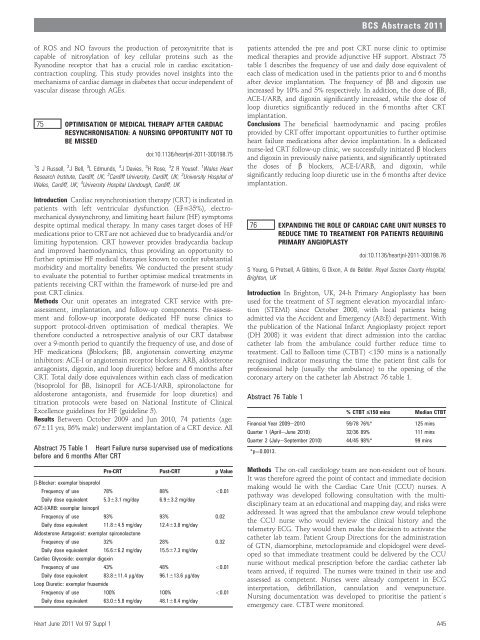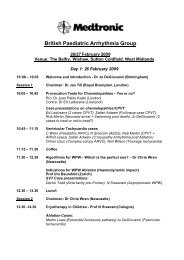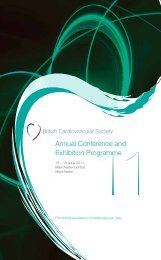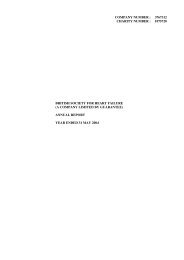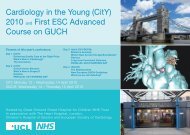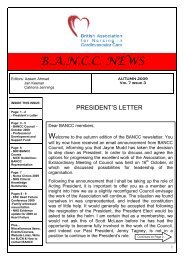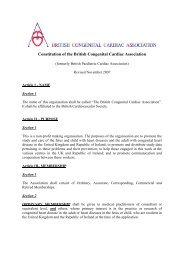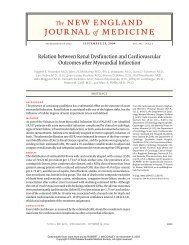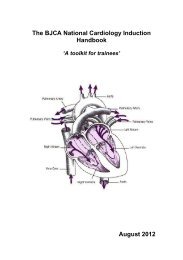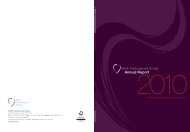Full Supplement - British Cardiovascular Society
Full Supplement - British Cardiovascular Society
Full Supplement - British Cardiovascular Society
Create successful ePaper yourself
Turn your PDF publications into a flip-book with our unique Google optimized e-Paper software.
BCS Abstracts 2011<br />
of ROS and NO favours the production of peroxynitrite that is<br />
capable of nitrosylation of key cellular proteins such as the<br />
Ryanodine receptor that has a crucial role in cardiac excitationcontraction<br />
coupling. This study provides novel insights into the<br />
mechanisms of cardiac damage in diabetes that occur independent of<br />
vascular disease through AGEs.<br />
75 OPTIMISATION OF MEDICAL THERAPY AFTER CARDIAC<br />
RESYNCHRONISATION: A NURSING OPPORTUNITY NOT TO<br />
BE MISSED<br />
doi:10.1136/heartjnl-2011-300198.75<br />
1 S J Russell, 2 J Bell, 3 L Edmunds, 4 J Davies, 3 H Rose, 3 Z R Yousef. 1 Wales Heart<br />
Research Institute, Cardiff, UK; 2 Cardiff University, Cardiff, UK; 3 University Hospital of<br />
Wales, Cardiff, UK; 4 University Hospital Llandough, Cardiff, UK<br />
Introduction Cardiac resynchronisation therapy (CRT) is indicated in<br />
patients with left ventricular dysfunction (EF#35%), electromechanical<br />
dyssynchrony, and limiting heart failure (HF) symptoms<br />
despite optimal medical therapy. In many cases target doses of HF<br />
medications prior to CRTare not achieved due to bradycardia and/or<br />
limiting hypotension. CRT however provides bradycardia backup<br />
and improved haemodynamics, thus providing an opportunity to<br />
further optimise HF medical therapies known to confer substantial<br />
morbidity and mortality benefits. We conducted the present study<br />
to evaluate the potential to further optimise medical treatments in<br />
patients receiving CRT within the framework of nurse-led pre and<br />
post CRT clinics.<br />
Methods Our unit operates an integrated CRT service with preassessment,<br />
implantation, and follow-up components. Pre-assessment<br />
and follow-up incorporate dedicated HF nurse clinics to<br />
support protocol-driven optimisation of medical therapies. We<br />
therefore conducted a retrospective analysis of our CRT database<br />
over a 9-month period to quantify the frequency of use, and dose of<br />
HF medications (bblockers; bB, angiotensin converting enzyme<br />
inhibitors: ACE-I or angiotensin receptor blockers: ARB, aldosterone<br />
antagonists, digoxin, and loop diuretics) before and 6 months after<br />
CRT. Total daily dose equivalences within each class of medication<br />
(bisoprolol for bB, lisinopril for ACE-I/ARB, spironolactone for<br />
aldosterone antagonists, and frusemide for loop diuretics) and<br />
titration protocols were based on National Institute of Clinical<br />
Excellence guidelines for HF (guideline 5).<br />
Results Between October 2009 and Jun 2010, 74 patients (age:<br />
67611 yrs, 86% male) underwent implantation of a CRT device. All<br />
Abstract 75 Table 1 Heart Failure nurse supervised use of medications<br />
before and 6 months After CRT<br />
Pre-CRT Post-CRT p Value<br />
b-Blocker: exemplar bisoprolol<br />
Frequency of use 78% 88%


